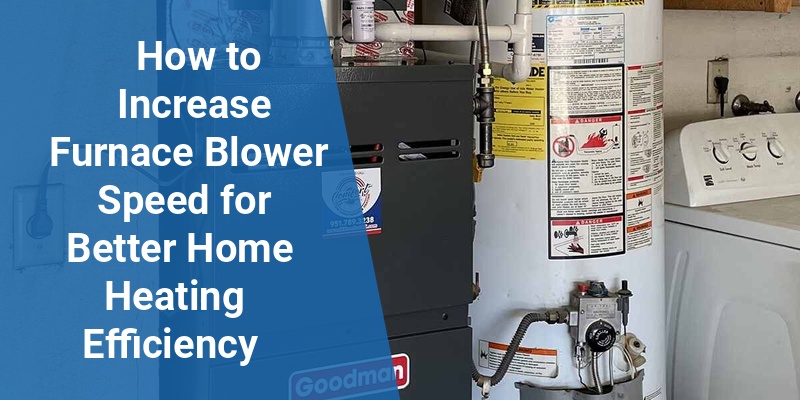Improving furnace blower speed can significantly impact your home’s heating performance and energy efficiency. The blower motor circulates warm air through your ductwork, so adjusting its speed may enhance comfort and reduce heating costs. This article explores the practical steps to increase furnace blower speed, explains the types of blower motors, and offers guidelines to safely optimize your heating system.
| Aspect | Details |
|---|---|
| Purpose of Increasing Blower Speed | Enhance airflow, improve heat distribution, and increase comfort |
| Common Methods | Adjusting blower motor settings, replacing the speed control board, upgrading to a variable-speed motor |
| Types of Blower Motors | Single-speed, multi-speed, and variable-speed motors |
| Precautions | Avoid overheating, ensure compatibility with furnace amps and wiring, consult HVAC professionals |
Understanding Furnace Blower Motors and Speeds
Furnace blower motors are responsible for pushing warm air through your heating system’s ductwork into your living spaces. Blower motors generally come in three types: single-speed, multi-speed, and variable-speed. Single-speed motors operate at a fixed airflow rate which cannot be altered, while multi-speed motors can run at several preset speeds, and variable-speed motors adjust airflow continuously based on heating demands, improving efficiency.
Knowing your furnace motor type is essential before attempting any adjustments, as different motors have distinct control mechanisms and wiring setups.
Why Increasing Blower Speed Can Improve Home Heating
Increasing the blower speed can enhance air circulation, resulting in more consistent and quicker heating. When warm air moves faster through the ductwork, rooms heat more evenly, reducing cold spots. Faster airflow can also improve indoor air quality by better distributing air through filters and ventilation.
However, it’s crucial to balance speed with the furnace’s design limits. Excessive blower speed may stress components, cause noise, or reduce heating efficiency if heated air passes too quickly through the heat exchanger.
Methods to Increase Furnace Blower Speed
1. Adjusting the Blower Motor Tap Settings
Many multi-speed blower motors have taps or wires that can be switched to increase or decrease motor speed. This involves accessing the furnace blower motor wiring and selecting a higher-speed tap. Ensure to turn off power before modifying wiring to avoid electric shock.
This method is relatively straightforward but limited to the motor’s preset speed options. Always check the furnace manual for exact blower motor wiring diagrams.
Call 888-906-9139 for Free Local HVAC Quotes – No Obligation, Just Savings!
2. Replacing the Blower Motor Control Board or Speed Controller
Some furnace models use an external control board or speed controller to regulate blower motor speed electronically. Upgrading or reprogramming this controller can allow for higher blower speeds or smoother step changes. This often requires professional HVAC assistance, as the control board needs compatibility with the furnace and motor type.
3. Installing a Variable-Speed Blower Motor
For optimal airflow customization and energy efficiency, upgrading to a variable-speed blower motor is the best solution. These motors adjust speed automatically based on demand, providing steady airflow and reducing energy use.
Variable-speed motors can increase blower speed when needed and slow down during lower heating loads, enhancing comfort and reducing noise. However, this upgrade involves significant cost and professional installation.
Important Safety and Performance Considerations
Before increasing your furnace blower speed, consider these critical factors:
- Manufacturer Specifications: Check furnace and motor ratings to avoid exceeding maximum speeds that cause overheating.
- Electrical Compatibility: Ensure that wiring and speed taps match the furnace’s voltage and amperage requirements.
- System Balance: Increasing blower speed may require ductwork evaluation to ensure consistent air delivery without pressure issues.
- Professional Assessment: Consulting an HVAC technician is advisable before making modifications to prevent damage or safety hazards.
How to Safely Access and Modify Blower Motor Settings
Start by turning off the furnace power at the breaker panel to avoid electrical shock. Remove the furnace blower access panel to locate the motor and wiring. Identify the speed taps or control board connectors using the furnace wiring diagram available in the user manual or on the furnace itself.
After identifying the current speed connection, switch to a higher-speed tap or adjust the control board settings if applicable. Replace panels and restore power only after ensuring proper and secure connections.
Potential Downsides of Increasing Furnace Blower Speed
While increasing blower speed improves airflow, it can also:
Call 888-906-9139 for Free Local HVAC Quotes – No Obligation, Just Savings!
- Lead to excessive noise from the motor and duct vibrations.
- Cause reduced heat transfer efficiency if warm air moves too quickly past the heat exchanger.
- Increase wear on motor bearings and components, shortening blower motor lifespan.
- Change air pressure and balance, potentially stressing duct systems and reducing comfort in some rooms.
Maintaining Optimal Furnace Blower Performance
Regular furnace maintenance can help keep blower motor efficiency high and reduce the need for speed adjustments. This includes:
- Changing air filters monthly to avoid airway blockages.
- Cleaning blower wheels and motor housing to maintain airflow.
- Lubricating motor bearings if applicable.
- Scheduling annual professional HVAC inspections to detect underlying issues.
Summary Table: Blower Motor Types and Speed Adjustment Options
| Blower Motor Type | Speed Adjustment Method | Advantages | Considerations |
|---|---|---|---|
| Single-Speed Motor | None (fixed speed) | Simple, low-cost | No flexibility to increase speed |
| Multi-Speed Motor | Switch wiring taps | Easy to increase speed within preset levels | Limited to predefined speeds, requires safe wiring changes |
| Variable-Speed Motor | Electronic control board | Continuous speed control, energy efficient | Coster upgrade and professional installation required |
